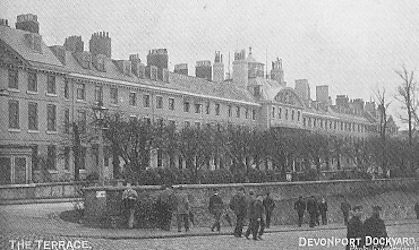|
OLD DEVONPORT
. UK |
||
|
© Brian
Moseley, Plymouth Webpage created: March 21, 2016 Webpage updated: May 27, 2019 |
||
|
THE TERRACE
The Terrace in the South Yard of the Royal
Dockyard. The Terrace was a block of thirteen houses for the accommodation of the Commissioner of the Yard and his twelve most senior officers. It was built of brick and was just over 400 feet from end to end. At each end was an office, the whole linked by a terrace or forecourt at the front, where, it was thought, the important officers would meet on a daily basis to discuss the work they were undertaking. It had a commanding view over the docks and quays below, and, of course, over the workmen there engaged. During the construction of The Terrace the then Commissioner decided to have a third storey added to the houses and some ten years later another Commissioner quietly added a summer house, coach house, an extra garden wall and a covered way to his property without the immediate knowledge of the Navy Board. From north, near the Dockyard Gate, to south the houses were initially occupied by Second Assistant to the Secretary; Captain of the Dockyard; Superintending Civil Engineer; Constructive Manager; Constructor; Admiral-Superintendent; First Assistant to the Engineer Manager; Fleet Surgeon; Captain of the Dockyard; Naval Store Officer; Boatswain; First Assistant to Electrical Engineer. At the northern end of the block was the Superintending Civil Engineer's Office and at the southern end the Admiral-Superintendent's Office. Those in residence in 1914 were: at number 2, R F Franklin, secretary to the Civil Engineer; number 3, Lieutenant A T Stewart, assistant to the Constructive Department; number 4, G P Hayes, superintendent; number 5, W T Hockaday, Constructive Manager; number 6, E J W Milton, Constructor; number 7, Rear-Admiral G H B Mundy; number 8, Engineer-Commander C A Harding RN; number 9, Fleet-Surgeon R D Jameson; number 10, H J L Clarke, Captain of the Dockyard; number 11, J W L Oliver, Naval Store Officer; and number 12, Boatswain C E Kevern RN. Number 13 was empty.
Unfortunately, during
the night of April 22nd/23rd 1941 all but the two northern-most houses were
destroyed. |
||
